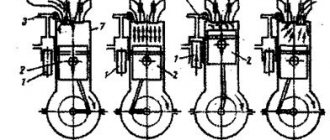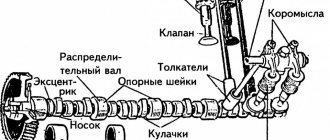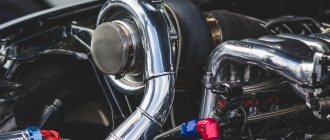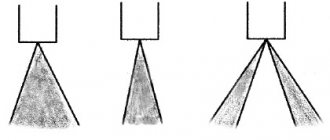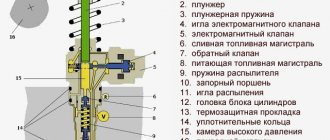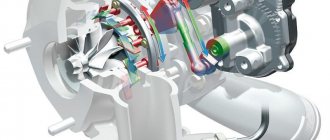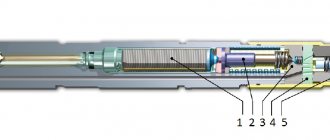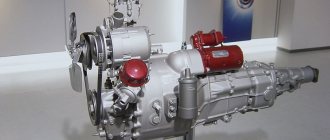Many novice motorists who recently purchased their vehicle are trying to understand the features of its design. In particular, it's helpful to understand what's under the hood. And the engine is of particular interest in this regard. This is an extremely complex mechanism consisting of various parts. Therefore, it is worth understanding this matter, at least in order to independently eliminate a number of malfunctions. At the same time, inexperienced car enthusiasts are not able to fully understand the difference between compression and compression ratio. But there is a difference, because each of these terms corresponds to its purpose.
Compression ratio
First, let's look at what should be understood by this term. The compression ratio is a geometric quantity that has no units of measurement. This is due to the fact that the parameters of the power unit are used to determine it. In other words, the compression ratio is the ratio of the entire volume of the cylinder to the volume of the combustion chamber.
For engines running on gasoline, this value can vary dramatically - in the range from 8 to 12. As for diesel power units, they have this characteristic even greater - 14-18 units. This is largely dictated by design features.
In search of an answer to the question of what is the difference between compression ratio and compression ratio, it is worth considering another point regarding gasoline engines. Here's the thing. The higher the compression ratio, the higher the power density. At the same time, a strong increase in this parameter will inevitably lead to a noticeable decrease in the service life of the motor. And on top of that, serious problems can arise if you fill your car with low-quality fuel.
Some interesting facts
Methanol race car engines have a compression ratio of over 15:1. By comparison, a standard carbureted engine consuming unleaded gasoline has a maximum compression of 1.1:1.
Of the production models of gasoline engines with 14:1 compression, there are models on the market from Mazda (Skyactiv-G series), installed, for example, on the CX-5. But their actual coolant is within 12, since these engines use the so-called “Atkinson cycle”, when the mixture is compressed 12 times after the valves are closed late. The efficiency of such engines is measured not by compression, but by expansion ratio.
In the middle of the 20th century, in the global engine industry, especially in the USA, there was a tendency to increase the compression ratio. Thus, by the 70s, the bulk of American automobile industry samples had a coolant ratio from 11 to 13:1. But the normal operation of such internal combustion engines required the use of high-octane gasoline, which at that time could only be produced by the ethylation process - by adding tetraethyl lead, a highly toxic component. When new environmental standards appeared in the 1970s, leaded lead was banned, and this led to the opposite trend - a decrease in coolant in production engines.
Modern engines have an automatic ignition angle control system, which allows the internal combustion engine to operate on “non-native” fuel - for example, 92 instead of 95, and vice versa. The OZ control system helps to avoid detonation and other unpleasant phenomena. If it is not there, then, for example, if you fill an engine with high-octane gasoline that is not designed for such fuel, you can lose power and even fill the spark plugs, since the ignition will be late. The situation can be corrected by manually setting the OZ according to the instructions for a specific car model.
Calculation of compression ratio
For any internal combustion engine, it is important that this parameter has the maximum possible value. However, if you need to force the engine, you should know how this characteristic can be calculated. This is necessary in order to avoid detonation, which can cause the engine to simply fail.
The formula used for the calculation is as follows:
CR=(V+C)/C,
where CR is the compression ratio, V is the working volume of the cylinder, C is the volume of the combustion chamber.
The car enthusiast who wants to know the difference between compression and compression ratio will be interested in such calculations. Perhaps this will be useful to him in practice.
To determine this parameter for only one cylinder, the total engine displacement should be divided by the number of “glasses”. As a result, we obtain the value of V from the formula above.
But determining the C indicator is much more difficult, but still possible. To do this, experienced motorists and mechanics involved in engine repairs have the right tool in mind - a burette. It is graduated in cubic centimeters. The easiest way is to pour gasoline into the combustion chamber, and then measure its volume with a burette. All that remains is to enter the obtained data into the formula.
Practical calculation by pouring method
The essence of the measurement is to alternately fill with liquid the area above the piston, when it is at top dead center, and the walls of the cylinder head combustion chamber. To measure, we need a piece of plexiglass in which holes will be cut for screwing in the cylinder head bolts and a hole for filling the liquid. Between the plexiglass and the block it is necessary to install an already used (crimped) gasket. To increase hydraulic tightness, the cylinder walls must be lubricated with thick grease (lithium or ordinary grease).
After tightening the plexiglass with bolts, fill the resulting volume with liquid. The volume of water placed will correspond to the volume of the space above the piston. A similar test is carried out with the block head. In this case, the valves must be ground in, and grease must be applied between the seats and plates. The sum of the volume of liquids filled will be the volume of the combustion chamber.
To calculate the compression ratio using an online calculator, it will also be necessary to measure the piston stroke and cylinder diameter. All these values will help to calculate the engine volume, which changes with each milling of the planes of the cylinder head, cylinder head, installation of pistons of a different geometric shape, boring of the cylinders, or installation of other connecting rods or crankshaft.
Compression
Now let's get acquainted with this characteristic. Unlike the compression ratio, compression is the pressure in the cylinder at the end of the stroke. And this characteristic is a physical quantity, so it can already be measured. For this purpose, special equipment is used - a compression meter.
From a theoretical point of view, this parameter should be equal to the compression ratio. But this is all just in theory, in reality everything is different. Compression is almost always greater than the compression ratio. This is due to several reasons, which will be discussed further.
Some interesting facts
Methanol race car engines have a compression ratio of over 15:1. By comparison, a standard carbureted engine consuming unleaded gasoline has a maximum compression of 1.1:1.
Of the production models of gasoline engines with 14:1 compression, there are models on the market from Mazda (Skyactiv-G series), installed, for example, on the CX-5. But their actual coolant is within 12, since these engines use the so-called “Atkinson cycle”, when the mixture is compressed 12 times after the valves are closed late. The efficiency of such engines is measured not by compression, but by expansion ratio.
In the middle of the 20th century, in the global engine industry, especially in the USA, there was a tendency to increase the compression ratio. Thus, by the 70s, the bulk of American automobile industry samples had a coolant ratio from 11 to 13:1. But the normal operation of such internal combustion engines required the use of high-octane gasoline, which at that time could only be produced by the ethylation process - by adding tetraethyl lead, a highly toxic component. When new environmental standards appeared in the 1970s, leaded lead was banned, and this led to the opposite trend - a decrease in coolant in production engines.
Modern engines have an automatic ignition angle control system, which allows the internal combustion engine to operate on “non-native” fuel - for example, 92 instead of 95, and vice versa. The OZ control system helps to avoid detonation and other unpleasant phenomena. If it is not there, then, for example, if you fill an engine with high-octane gasoline that is not designed for such fuel, you can lose power and even fill the spark plugs, since the ignition will be late. The situation can be corrected by manually setting the OZ according to the instructions for a specific car model.
Explanation of theory and practice
Both characteristics will be equal only in the case when infinitely long isometric compression of the gas occurs in the cylinders. As a result, the released energy will be absorbed by the piston, cylinder walls, cylinder head and other parts of the engine, and completely. Due to this, the heat balance will not change. The compressed gas gives off heat, but does not press on the pressure gauge with greater force than the calculated value.
In practice, everything is different - there is a difference between compression and compression ratio in the readings. The process is adiabatic in nature. Gas compression is accompanied by a significant increase in temperature.
Not all the heat generated by the compressed gas is absorbed by the walls of the cylinder, and for this reason pressure is generated due to the remainder.
How to check engine compression
When taking measurements, the following regulations are usually followed: the engine must be warmed up to operating temperature (not always), the air filter must be removed and/or the throttle valve unit must be disconnected (if possible), or the throttle valve must be fully open; if there is a carburetor, the air valve must be fully open valve, the spark plugs (for diesel engines - glow plugs) are turned out from all cylinders. Of course, for the event to be carried out correctly, the gas distribution mechanism must be correctly adjusted (at a minimum: the marks are in place, there are no “jumps”, and the tensioners and their “shoes” have normal wear), the starter must be in working order, and the battery must be fully charged.
An example of a simple design compression gauge
Compression meters are devices for measuring compression. Their design and construction can vary greatly, as can the price - from a “mower” for the simplest manufactured product to hundreds of thousands of rubles for a professional diagnostic device with many additional functions. But the operating principle is the same for everyone.
Diagnostic tool with engine compression and leak detection functions
Typically, compression gauges have a tip that is hermetically connected to the spark plug hole and a pressure gauge “with memory” and a check valve. The pressure gauge needs “memory” to record (“memorize”) the maximum pressure developed over ten revolutions of the crankshaft. After attaching the tip, you need to turn the ignition key and, using the starter, let the engine make about a dozen revolutions. On the dial (or display) of the device we will see the amount of compression in a given cylinder. “For the purity of the experiment,” measurements must be carried out 3-5 times, after which the arithmetic average value must be entered into the table.
Measuring compression in engine cylinders
Old and new engines
In engines that have already worked for a considerable period of time, compression rates will be noticeably lower than those of recently released power units. This is due to the tightness. New car engines are largely gas-tight. Therefore, much heat will not be released through the ring locks and other places in the cylinders. Accordingly, the compression will not drop. The difference in compression and compression ratio will be minimal.
With old engines everything is clear - service life does its job. And as a result of long-term use of the vehicle, including exposure to high temperatures, the elements lose their original properties. Of course, this happens over a long period of time, but one way or another, the characteristics of the engines change in any case.
Factors influencing compression reduction
- Engine mileage is the actual state of the engine's CPG; it is one of the most significant factors that influence the state of compression. The better the grinding in of parts in the engine, the less gas leakage occurs through the leaks that have arisen, and the longer the engine is in operation, the more the production of associated parts increases, reducing compression (not counting the running-in of a new internal combustion engine).
- Aggressive driving - sharply changing amplitude of load and engine speed, which is associated with sudden braking or over-throttle, contributes to faster wear of the CPG.
- The serviceability of the clutch and gearbox, which affect the smoothness and dynamic load in the engine.
- Quality of lubricants and fuel – it is very important to use high-quality “branded” oils and high-quality fuel.
- Starting at low air temperatures, without warming up the oil. Solidified oil does not pass through the channels, reducing lubrication of rubbing surfaces, which increases wear.
- Quality of ignition control and fuel injection.
Ways to change the compression ratio
With modern power units, this characteristic can be adjusted both up and down. If you need to increase the parameter, then the cylinders are bored and pistons with a larger diameter are installed. Anyone interested in understanding the differences in combustion engine compression and compression ratio will find this information helpful. After all, among car enthusiasts there are supporters of various types of tuning.
Another, no less effective way to change the compression ratio is to reduce the combustion chamber. In this case, a layer of metal is removed from the junction of the cylinder head with the engine block. This operation is carried out using a planing or milling machine.
If for some reason there is a need to lower the compression ratio, then, on the contrary, it is worth placing an alloy gasket between the cylinder block and the cylinder head. Another method is to remove a layer of metal from the piston bottom. However, it is more difficult to implement, since it will require certain efforts, skills and abilities. In addition, this procedure requires a lathe.
Analysis of measurement data
Measuring the compression difference between cylinders should not exceed 12% . If pressure is lower in any cylinder, this clearly indicates a malfunction. To preliminary determine the malfunction, it is necessary to add 5-10 grams of engine oil to this cylinder and repeat the measurement again. If the compression has increased, coking of the compression rings is possible; in this case, the procedure for flushing the internal combustion engine can help. If this does not help, you need to contact an internal combustion engine repair specialist.
Comparison results
Ultimately, what is the difference between compression ratio and compression ratio? Analyzing these two terms, you can notice a significant difference. The compression ratio is a dimensionless quantity. It can be changed, but only by interfering with the engine design.
Compression can vary during the operation of the vehicle. In addition, this parameter largely depends on the compression ratio. After all, the pressure in a smaller volume will always be greater.
In other words, if the compression ratio increases, then the compression also increases.
Method No. 2. Power increasing blocks
The popularity of using blocks to increase the power of a diesel engine is explained by their versatility, quick installation and ability to significantly save fuel.
Among the disadvantages, it is worth noting a decrease in the service life of the cylinder block, injectors and injection pump and the rapid depletion of the particulate filter. Also, the modular method, in contrast to properly carried out chip tuning, increases the emission of harmful substances.
Block for improving the operating modes of the ECU CPU
The unit is included in the high-pressure fuel system and its computing module controls engine operation, bypassing the ECU, without underestimating sensor readings. By diagnosing the pressure in the fuel system, and when it increases, it sends a command to the control unit to increase the injector timing within the permissible range.
Injector control module
Installing the module allows you to control and change injector control pulses. The module is connected to the injector wire gap and regulates the operation of the fuel injector by changing the opening time of the injector needle. As a result, the fuel injection angle changes and combustion efficiency increases.
Module for changing the fuel injection pump operation scheme
Installed on diesel engines with a mechanical injection system. The block increases the power of a diesel engine due to changes in the functioning of the fuel pump. The module adjusts the fuel sensor data to lower values. As a result, pressure increases in the fuel pump housing using a solenoid valve.
The positive aspects of this method include inexpensive equipment and ease of installation. The disadvantages include floating engine speeds and reduced fuel injection pump life.
Module for converting fuel rail pressure sensor data
The equipment connects to the wires of the rail pressure sensor and sends data about a decrease in compression in the fuel rail to the electronic control unit. The ECU changes the intensity of the injectors, the power of the internal combustion engine increases, and fuel consumption decreases.
Module for reducing fuel accumulator pressure
The fuel pump is responsible for regulating the pressure level in the fuel accumulator. By installing an additional unit in the electronic circuit of the fuel system, information about the loss of fuel injection pump power is supplied to the ECU. The ECU will give a command to increase the injection timing.
Method number 3. Turbocharging
Engine performance is increased by installing a turbine, which supplies a large amount of air into the combustion chamber. The fuel system control unit gives a command to increase fuel injection and engine power increases.
The disadvantage of this method is the increase in fuel consumption and the short service life of the turbine. At the same time, turbocharging prevents the engine from stalling when you press the car's stop pedal.
How does the impact occur?
So what does the compression ratio affect? Here it is worth considering the amount of work that the power unit produces. And the higher this parameter, the more energy will be released during the combustion of the air-fuel mixture. Accordingly, engine power increases.
For this reason, most manufacturers are trying to increase the power performance of the motor through one effective technique. They began to resort to it since the end of the last century. Instead of moving in the direction of increasing the volume of the cylinders and combustion chamber, specialists, and they certainly know the difference between compression and compression ratio, strive to increase precisely the latter indicator.
However, there are limitations. The working mixture cannot be compressed indefinitely - upon reaching a certain value, it detonates, that is, explodes. At the same time, this only applies to gasoline engines. Diesel power units have no risk of detonation. Actually, this explains their higher compression ratio.
And in order to avoid such a destructive effect, because detonation is detrimental to the engine, the octane number of gasoline increases. And this, in turn, increases the cost of fuel. In addition, those additives that serve this purpose lead to a deterioration in the environmental parameters of the engine.
Miller-Atkinson cycle
The Miller-Atkinson cycle gained great popularity thanks to Mazda advertising brochures. Marketers proudly declare that engineers managed to increase the compression ratio of the Skyactive model engines to 14 units. In fact, we are talking about the geometric compression ratio, not the actual one.
The trick is that during the rise of the piston on the compression stroke, the exhaust valves are still open for a long time, which is why part of the fresh air charge is pushed into the exhaust tract. Therefore, the actual degree is close to the standard 12 units for gasoline engines. An increase in thermal efficiency is achieved through more efficient use of the energy of expanding gases during the power stroke. Due to the longer stroke (increased crank diameter), the gases press on the piston longer. Therefore, when the same proportion of fuel is burned, compared to the conventional Otto cycle, more torque is transmitted to the crankshaft. The technology makes it possible to significantly reduce fuel consumption and the amount of harmful emissions in low and medium load modes.
Deboosting for low octane fuel
This operation is carried out when the issue of power is secondary, and the main task is to adapt the engine to a different fuel. This is done by reducing the compression ratio, which allows the engine to run on low-octane gasoline without detonation. In addition, there are certain financial savings on the cost of fuel.
Interesting: a similar solution is often used for carburetor engines of old cars. For modern electronically controlled fuel injection engines, deforcing is highly not recommended.
The main way to reduce the engine compression ratio is to make the cylinder head gasket thicker. To do this, take two standard gaskets, between which an aluminum gasket insert is made. As a result, the volume of the combustion chamber and the height of the cylinder head increase.

